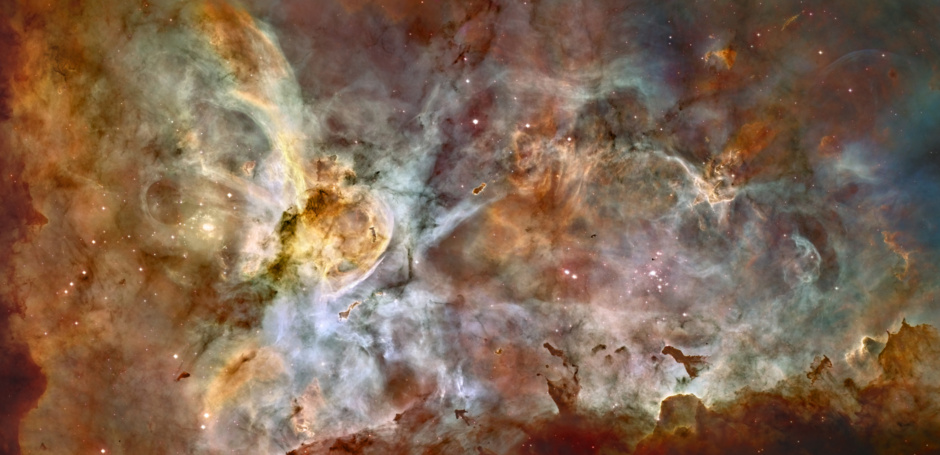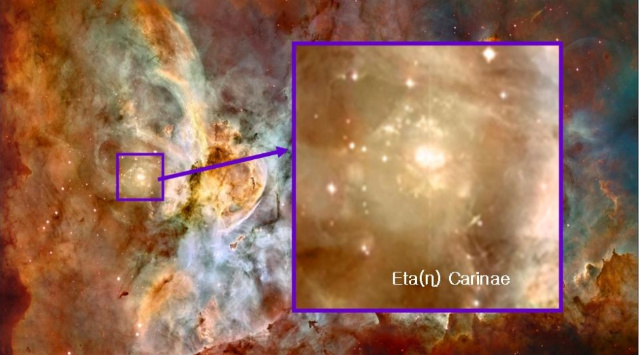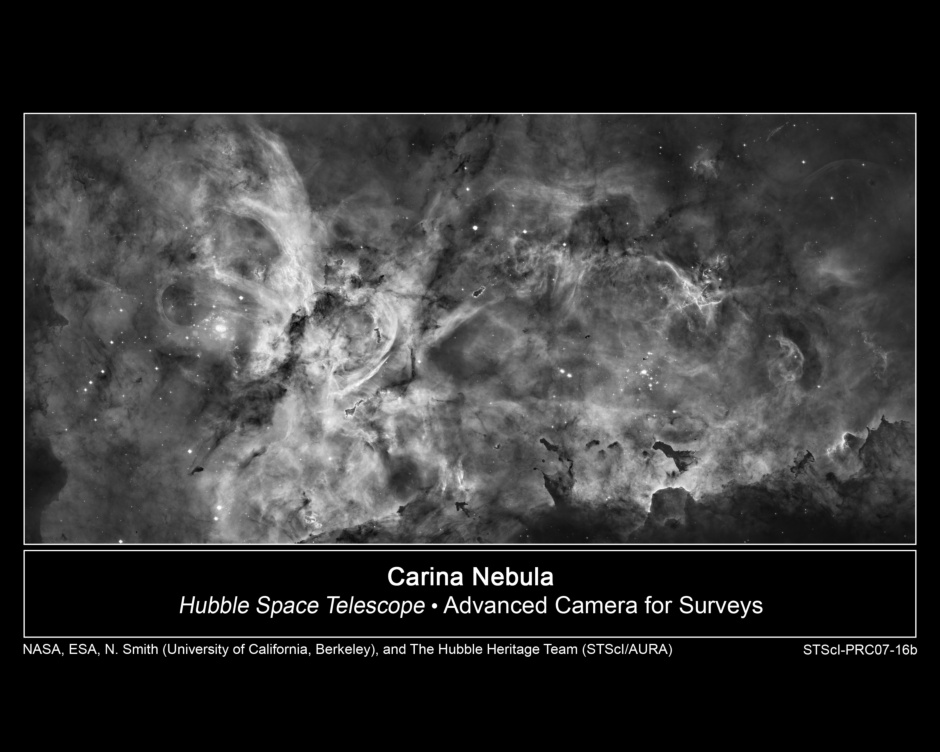허블에서 2007년 4월에 발표된 용골성운에 대한 뉴스입니다.
허블 우주 망원경의 발사 및 설치 17주년을 기념하는 뉴스라서 그런지, 평소보다 많은 분량의 사진과 리포트를 담고 있습니다.
세 차례에 나누어서 싣습니다.
나사의 허블우주망원경 발사 17주년 기념식에서, 지금까지 허블로 촬영된 우주 이미지 중 가장 큰 규모의 사진이 발표되었다.
이 이미지는 별들의 탄생과 죽음이 반복되고 있는 카리나 성운의 중심부분으로 가로 폭 50광년의 거리를 담은 이미지이다.
허블의 이미지는 이 성운에서 별들이 탄생하는 지역에 대해 지금까지와는 차원이 다른 고해상도의 이미지를 제공하고 있다.
사진에 나타나고 있는 환상적인 광경은 별들로부터 뿜어져 나오는 폭풍으로 조각되고, 자외선 복사에 의해 맹렬하게 타들어가면서
만들어진 현상이다.
이러한 와중에 별들은 그들이 탄생했을 때 발생한 거대한 먼지구름의 잔존물들로 이루어진 주변의 물질들을 잘게 찢어내게 된다.
거대한 성운은 태양보다 최소 50배에서 100배에 이르는 빛나는 별들을 최소한 수십개 포함하고 있다.
이곳에서 가장 독특하고 화려한 터줏대감은 왼쪽 멀리에 위치해 있는 Eta Carinae라는 별이다.
Eta Carinae 는 짧고 격동적인 수명의 마지막 단계에 접어든 별로서 가스와 먼지들로 이루어진 크게 부풀어오른 두개의 돌출부는 거대 초신성으로서의 폭발이 임박했음을 알려주는 전조이다.
용골자리에서 이러한 불꽃놀이가 시작된것은 300만년 전에 차갑게 냉각된 수소 분자 구름에서 응축과 발열로 새로운 별들이 태어나기 시작했던 때부터였다.
이들 별들로부터 발생한 복사열이 뜨거운 가스구름을 팽창시켰다.
성운에 골고루, 섬과 같이 퍼져 있는 암흑구름은 광전리현상의 잠식에서 살아남은 먼지와 가스의 뭉치들이다.
(광전리현상 : 원자 또는 분자가 광량자를 흡수하고 전자를 잃어버리게 됨에 따라 양의 전하를 가지게 되는 과정)
별로부터 발생하는 폭풍과 진공 공간을 부풀리는 자외선 복사가 주위를 감싸고 있는 차가운 수소의 벽을 압박하고 있다.
이것은 새로운 별을 만들어내는 두 번째 단계의 시발점이다.
우리의 태양과 태양계도 46억년 전에 이와 같은 우주적인 용광로 상태에서 탄생한 것으로 생각된다.
카리나 성운을 관측해 보면 나선형 은하 중에서 빽빽한 밀도를 이루는 은하의 팔부분에서 일반적으로 관측되는 유형과 같은 별의 형성을
관찰할 수 있다.
이 거대한 성운은 남반구의 용골자리에 대략 7500광년 거리에 있다.
(그리스 신화의 야손과 아르고나스의 항해에서 유래한 이 별자리의 옛날 이름은 아르고자리이다.)
이 이미지는 허블 우주망원경 ACS(Advanced Camera for Surveys)로 촬영된 48개 프래임을 조합한 것으로 이 허블 이미지는 중성수소광으로 촬영되었다.
색채 정보는 칠레의 체로 톨로로 전미 천문대(CTIO : the Cerro Tololo Inter-American Observatory)의 데이터를 통해 추가된 것이다.
붉은 색은 황, 초록색은 수소, 파란색은 산소 복사이다.
이 동영상은 Carina 성운의 이미지를 동영상으로 구성한 허블 사이트의 공식 배포 동영상입니다.
< 설명 : 이 성운의 환상적인 광경은 거대한 별이나, 성단, 그리고 대전원자(전기적 에너지를 보유한 원자)를 포함한 항성폭풍(태양과 같은 별에서 방출되는 광폭풍)의 강력한 압력에 의하여 조각된 것이다.
Caterpillar라는 애칭을 가진 Bok globule의 경계면확장은 성단 내 초고온의 별에 의한 광전리현상이 발생하고 있음을 나타내는 증거이다.
별들은 이처럼 일종의 먼지고치에서 형성되는 듯 하다. 용골자리에서 가장 오래된 천체인 Keyhole성운이 가장 윗쪽에 보인다.
성운의 가장 자리의 분자구름 표면에 차가운 수소 가스의 기둥이 있다.>
* '허블사이트'의 게시물들은 허블사이트 http://hubblesite.org 의 뉴스센터 자료들을 번역한 자료들입니다
참고 : 카리나성운을 비롯한 각종 성운에 대한 포스팅은 하기 링크 INDEX를 통해 조회할 수 있습니다.
https://big-crunch.tistory.com/12346974
원문>
In celebration of the 17th anniversary of the launch and deployment of NASA's Hubble Space Telescope, a team of astronomers is releasing one of the largest panoramic images ever taken with Hubble's cameras. It is a 50-light-year-wide view of the central region of the Carina Nebula where a maelstrom of star birth - and death - is taking place.
Hubble's view of the nebula shows star birth in a new level of detail. The fantasy-like landscape of the nebula is sculpted by the action of outflowing winds and scorching ultraviolet radiation from the monster stars that inhabit this inferno. In the process, these stars are shredding the surrounding material that is the last vestige of the giant cloud from which the stars were born.
The immense nebula contains at least a dozen brilliant stars that are roughly estimated to be at least 50 to 100 times the mass of our Sun. The most unique and opulent inhabitant is the star Eta Carinae, at far left. Eta Carinae is in the final stages of its brief and eruptive lifespan, as evidenced by two billowing lobes of gas and dust that presage its upcoming explosion as a titanic supernova.
The fireworks in the Carina region started three million years ago when the nebula's first generation of newborn stars condensed and ignited in the middle of a huge cloud of cold molecular hydrogen. Radiation from these stars carved out an expanding bubble of hot gas. The island-like clumps of dark clouds scattered across the nebula are nodules of dust and gas that are resisting being eaten away by photoionization.
The hurricane blast of stellar winds and blistering ultraviolet radiation within the cavity is now compressing the surrounding walls of cold hydrogen. This is triggering a second stage of new star formation.
Our Sun and our solar system may have been born inside such a cosmic crucible 4.6 billion years ago. In looking at the Carina Nebula we are seeing the genesis of star making as it commonly occurs along the dense spiral arms of a galaxy.
The immense nebula is an estimated 7,500 light-years away in the southern constellation Carina the Keel (of the old southern constellation Argo Navis, the ship of Jason and the Argonauts, from Greek mythology).
This image is a mosaic of the Carina Nebula assembled from 48 frames taken with Hubble Space Telescope's Advanced Camera for Surveys. The Hubble images were taken in the light of neutral hydrogen. Color information was added with data taken at the Cerro Tololo Inter-American Observatory in Chile. Red corresponds to sulfur, green to hydrogen, and blue to oxygen emission.
For more information, contact:
Nathan Smith
University of California, Berkeley, Berkeley, Calif.
(phone) 510-642-6931, (e-mail) nathans@astro.berkeley.edu
Nolan Walborn
Space Telescope Science Institute, Baltimore, Md.,
(phone) 410-338-4915, (e-mail) walborn@stsci.edu
Ray Villard
Space Telescope Science Institute, Baltimore, Md.,
(phone) 410-338-4514), (e-mail) villard@stsci.edu
Keith Noll
Space Telescope Science Institute, Baltimore, Md.,
(phone) 410-338-1828, (e-mail) noll@stsci.edu
Lars Lindberg Christensen
ESA/Hubble/ST-ECF, Garching, Germany,
(phone) 49-89-320-06-306, (cell phone) 49-173-38-72-621, (e-mail) lars@eso.org
Object Names: Carina Nebula, NGC 3372
'3. 천문뉴스 > 허블사이트' 카테고리의 다른 글
| Carina Nebula, NGC3372 -3- (0) | 2007.11.12 |
|---|---|
| Carina Nebula, NGC3372 -2- (0) | 2007.11.11 |
| Arp 87 (NGC 3808과 NGC 3808A) (0) | 2007.11.11 |
| NGC 2808:구상성단에서 별이 여러 시점에 만들어질 수 있는가에 대한 의 (0) | 2007.10.28 |
| MC2 1635+119 퀘이사 주변의 Shell 구조 (0) | 2007.10.27 |


